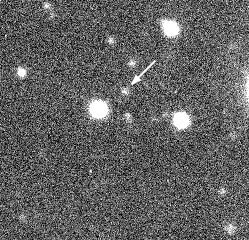
This discovery image shows one of Jupiter's 11 new satellites, designated, S/2001 J3, as seen in December 2001. Click on image to see the moon in motion.
Courtesy Scott Sheppard and David Jewitt (University of Hawaii).
Scott S. Sheppard and David C. Jewitt (University of Hawaii) announced yesterday the discovery of 11 new moons around Jupiter. With the finding, Jupiter now has 39 confirmed satellites.
The pair made their observations using the 3.6-meter Canada-France-Hawaii Telescope and 88-inch University of Hawaii telescope located on Mauna Kea, Hawaii. The first set of images were taken over six nights in December 2001. Follow-up observations conducted in January, February and May helped to confirm the new moons' location and motion around Jupiter.
The orbits were calculated by Brian G. Marsden (Harvard-Smithsonian Center for Astrophysics) and Robert A. Jacobson (Jet Propulsion Laboratory).
Jupiter's newest moons are all no more than 2 to 4 kilometers across (assuming their surfaces are very dark), and they all have retrograde (backward) orbits. Each has a period between 557 and 773 days.
The large, elongated, highly inclined nature of the orbits implies that all 11 objects were captured by Jupiter, probably early in the planet's history.
 0
0
Comments
You must be logged in to post a comment.